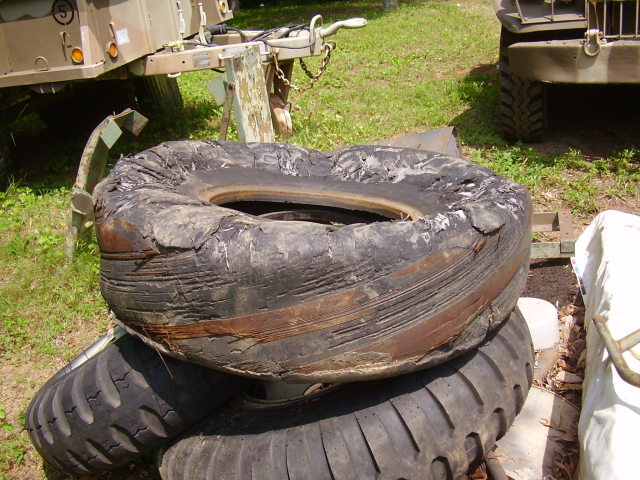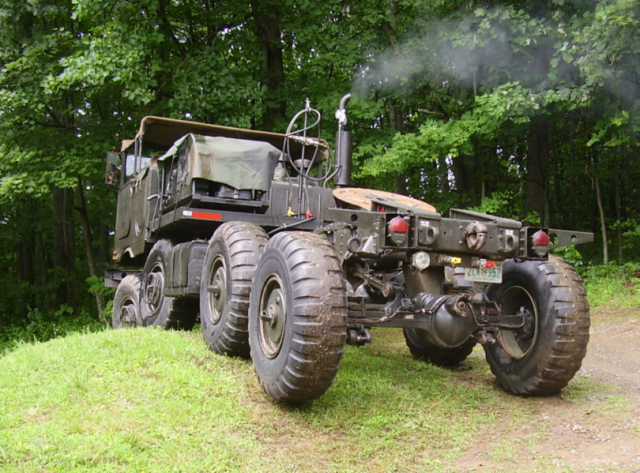Question Uniroyal military tire
Uniroyal military tire
QUESTION: Towing my 1969 military 8x8 truck from Oklahoma to Virginia one of the tires blew, losing its tread. The tires on the truck are generally dated in the 1980's, but this was the only radial, the other being bias ply 16/70-20 low pressure non directional military type tires.
With the tread gone, the steel belts are clearly visible and my question concerns the orientation of these steel cords. I have had the impression that the belts on radial tires are laid straight around the tire not diagonally as seen here (image attached), so is this significant?
Thanks,
Bjorn
ANSWER: Bjorn,
The belts on radial tires always have gone at about 15° from the circumferential direction - and that is pretty much what I see here.
This is significant, but that's the way it is supposed to be and has nothing to do with the failure.
BTW, from the condition of the sidewall, I would look for a puncture in the tread. The sidewall has the appearnce of a "run flat" - operating a tire with little or no inflation pressure. That is likely the source of the failure.
---------- FOLLOW-UP ----------
 Ford 1969 xm757
Ford 1969 xm757
QUESTION: Thank you!
I wasn't so much concerned about the reason for the failure, just the way the belts were laid down. The tires were exclusively made for this series of vehicles and I have great difficulty finding out anything about them.
I measured the angle and it's 20 degrees. The ends of the wires appear cut along the edges or are they folded under? Seems like it would make a stronger structure with the belts running uncut around the tire. The tires were designed for a 12 inch wide rim and the manuals call for 10 psi snow and sand with no de-rating for side slopes(30 psi highway). Current military vehicles must use highway tire pressure (about 50 psi) when negotiating side slopes and the off-road pressure on new vehicles, like the FMTV is specified at 20 psi. So, as you can see, they did something more "military" in those days and that makes me curious about the design.
Image of my 1969 Ford xm757 attached showing the bias ply tires.
Bjorn
Bjorn
AnswerBjorn,
The edges of the belt are cut - not folded over. Steel wire doesn't respond well to folding over. Fabric belts (polyester or rayon) have been tried and sometimes folded over, but steel wire works so well that fabric belts have been almost completely abandoned as a belt material.
The problem with putting the belts at zero degrees - or near zero degrees - is that the wire would have an overlap. This overlap causes all kinds of problems that are solved when a slight angle is used. The belts can be formed in sheets and can be formed in what appears to be a continuous layer. 2 belts going in opposite directions stabilizes the tread area, and allows the radial plies to be formed at almost any shape. It makes extremely low aspect ratio tires possible.
If the belt wires were to be at zero degrees, it would be a hoop. This means that the "hoop" would have to be formed prior to the application of the rubber layer around the wires. The adhesion of the rubber to the wire is extremely important for the structural integrity of the tire. using more conventional techniques of rubber application to the wire - called calendaring - forces the rubber between 2 rolls and that layer of rubber is forced into the wire - one form each side. The force of this application forces the rubber deep into the wire matrix, encouraging adhesion.
This is the way all steel belts are made and the system works pretty well. This also means that unusual tires can be built on standard tire making equipment without a great deal of cost.
In bias tires, the plies are built at an angle - something less than 45 degrees. While bias tires are fairly forgiving for side slopes, the radial is much better when operated on the tread area. The problem with bias tires is that they grow significantly when subjected to high speeds (centrifugal forces) and that limits the top speed of the vehicle - which is sometimes an overriding consideration.

